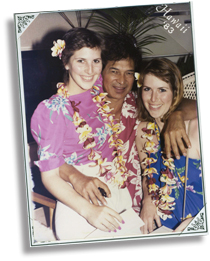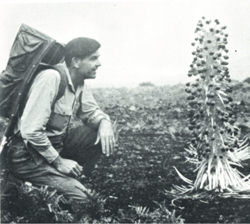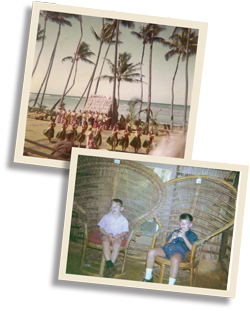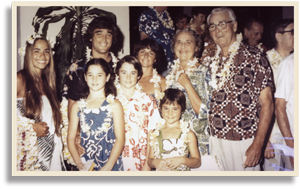One of the best aspects of Hawaiian culture has got to be the laid-back practice of storytelling—or as the locals say, “talk story.” Whether the speaker is a tutu from Wailuku who speaks effortless clipped pidgin English gesturing with large jiggly arms or a skinny tourist from Texas with hands in his pockets and a drawl, sharing life experiences enriches us all.
As the 50th state observes its 50th anniversary, we turn to a few readers for their fond Hawai‘i memories from the past five decades. While there wasn’t room for all their photos, we think they’ve captured the essence of why Hawai‘i remains such a beloved place.
A youthful Harold C. “Hal” Brown, now a Marin County supervisor, his sister and father, Judge Harold C. Brown Sr, arrived in Honolulu in July 1956 after a five-day Pacific crossing on the famed S.S. Lurline. His sister Helen recalls:
“The thing I remember consistently throughout the trip was the heavenly fragrance of flowers everywhere. The warm trade winds brought scents of plumeria, jasmine and gardenias. In most of the photos my brother and I are scowling; this has nothing to do with Hawai‘i—we adored the trip and loved being with our father. We (just) didn’t like our photos taken, and Dad would stop people on the street and say, ‘Look at my children, aren’t they wonderful?’—then tell us to ‘emote’ and take our photo. He was always trying to teach us new vocabulary, and ‘emote’ was his word for getting us to show some of our personality. He never used ‘say cheese.’ Everywhere we went we were treated like royalty. The only exception on the whole trip was when we went to the Outrigger Canoe Club, which was the Hawai‘i branch of the Lakeside Olympic Club. We showed up but my father and brother weren’t wearing the required jackets and ties so the mâitre d’ offered them the option of borrowing jackets and ties to wear over their aloha shirts or eating in the kitchen with the staff. We ended up eating dinner in the kitchen at a big round staff table and had so much fun.
We stayed at the Princess Ka‘iulani, the newest hotel at the time. While this was the first of many, many trips, at the time I thought, I hope I remember everything because this might be a once-in-a-lifetime trip.
Helen Brown, San Rafael

By the time Valary Bremier and her sister P. J. sidled up to sit on musician Don Ho’s lap for a photo in 1983, he had recorded 15 best-sellers, starred in his own TV show in the ‘70s and
performed nationwide sharing his brand of aloha.
“The trip I took to Hawai‘i with my sister and our great-aunt Pauline was a big adventure—with no parents! Upon arrival, we quickly sought out Hilo Hattie and bought pretty flowered pink blouses and pareos (sarongs), wearing them everywhere with fragrant plumeria leis and a hibiscus tucked behind our ears. We wove reed hats and learned to hula under the shade trees of the Hilton Hawaiian Village. I remember sitting in the bleachers to watch the hula dancers of the vintage Kodak show, drinking guava juice at every breakfast, learning to snorkel at Hanauma Bay and touring an almost deserted Iolani Palace.
Every evening started with mai tais decorated with little paper umbrellas and regardless of what else we did we always managed to listen to a few numbers by Barry Kim, who sang at the Hilton’s beachside lounge. My sister and I had a crush on him. The only night we two-timed him was when we got front row seats to the Don Ho show: fire dancers, hula girls, exotic costumes, corny jokes and Don Ho crooning ‘Tiny Bubbles.’ The house was packed and everyone was happy. Afterwards, we went backstage to meet him. He turned out to be as relaxed, friendly and funny as he had seemed on television specials.”
Valary Bremier, Greenbrae

Jet travel increased in the sixties allowing Hawai‘i to become an annual destination for many families.
“We first traveled to Hawai‘i in August 1968. I remember loving how a beautiful local girl (dressed in costume) greeted us at the Honolulu airport with the traditional orchid flower lei. While this still happens today, this tradition is not as elaborate as it was in 1968. We stayed at the Kuhio Palms on Kuhio Street, Waikiki. A few years later, I met Nick Sporick (in photo). He was 20 and I was 17; he was going to the University of Hawai‘i and was from New Jersey. Nick was teaching me how to surf off Waikiki beach. I looked forward to seeing him in Hawai‘i during holidays and summer breaks. When Nick graduated he became a pilot for the U.S. Air Force, flew for the Hawaiian Air National Guard and then flew for Aloha Airlines. Through the years we have remained friends and my twin sons played with his two daughters when we visited the islands. Nick lives in Kailua, on the island of Oahu. Back in 1968 we fell in love with the island spirit and culture and spent our summer vacations every year in Hawai‘i. And we still do to this day.”
Donna Whitney, San Rafael

Marty Griffin of Tiburon traveled to East Maui on an expedition to study a jungle valley adjacent to the Seven Sacred Pools, which had just been purchased by Laurence Rockefeller. Their findings of rare birds and plants led to acquisition of the land by the Nature Conservancy. This photo is from the November 1968 issue of Honolulu Magazine, where his article “The Wild Grandeur of Kipahulu” was published. “Dr. Martin Griffin, the author and expedition physician, here studies the rare silversword,” the photo caption read. In his article, Griffin recounts the trip:
“I was met in Hana by Dr. Milton Howell, a general practitioner who has served this isolated community of 1,300 persons for six years. He is co-chairman of the Valley of the Seven Sacred Pools project…The next morning I met Harry Hasegawa, expedition provisioner, who operates the third generation Hasegawa’s General Store at Hana. It has all the sights and smells and clutter a general store should have, plus a catchy tune which plays several times a day, titled ‘Hasagawa’s General Store,’ now a popular island song.”
L. Martin Griffin, Tiburon

The Kodak Hula Show was a fixture in Waikiki from 1937 through 2002. This daylight (easier to photograph) event was the brainchild of Fritz Herman, manager of Kodak Hawai‘i, and was the only exposure most visitors had to authentic hula. Iolani Palace is a Hawaiian national treasure and the only official state residence of royalty in the United States.
“I remember how beautiful (and big) the home of the late Queen Lili‘uokalani was to me back in 1964, when I visited Oahu with my family. My brother and I are sitting in the queen’s chairs in this photo. On the tour we learned that the queen was an accomplished musician and wrote the song ‘Aloha ‘Oe, which we learned to play on our new ukuleles. This was fun, but what I really remember paying attention to was the story of how the queen was held hostage in her palace because sugar barons had tricked her and then there was a military coup.
I was also fascinated by how King Kamehameha pushed his enemies off the (Nuuanu) Pali! That was a really long drop. I also liked the Kodak Hula Show where they made poi, and I tried it. A year later our family moved to Oahu to live. I wonder if my parents were actually researching our new home while we thought we were on vacation.”
Mike Ratiani, Mill Valley
The Question of Statehood
When Clifford Naeole talks enthusiastically about the future of Hawai‘i to tourists and locals, it’s obvious he’s not only qualified for his role as cultural adviser at the Ritz-Carlton, Kapalua, he seems destined for it. So when the idea of “celebrating” statehood came up, Naeole gently steered his well-intended colleagues instead toward the concept of “commemorating.” Why? He explains.
Can you explain why everyone may not be “celebrating”?
This is a complicated issue that has been debated at length in Congress as well as at many a kitchen table. For those who judge us from afar by what we fight for…I urge them to speak to a Hawaiian and understand that we are indeed a nation. Know also that these efforts are not “anti-American”…but rather “anti-abuse of power.” Here is a very brief explanation of why statehood is considered a controversy by Hawaiian people.
• On January 17, 1893, due to pressures from American businessmen, Queen Lili‘uokalani was held captive by a U.S. military coup in her palace. To prevent bloodshed, she eventually signed a statement under protest temporarily yielding her power to the U.S. government. A provisional government was established under businessman Sanford B. Dole.
• In a message to Congress on December 18, 1893, President Grover Cleveland concluded that this “act of war” had not been approved by Congress and a “substantial wrong has thus been done which a due regard for our national character as well as the rights of the injured people requires we should endeavor to repair” and called for the restoration of the Hawaiian monarchy.
• In 1898 President McKinley reversed Cleveland’s decision and signed a joint resolution of Congress on July 7 that annexed Hawai‘i to the United States.
• Leading up to the vote on statehood, much of the Hawaiians’ national land was seized for territorial use with still-unfulfilled contracts of financial retribution.
• On August 21, 1959, the people of Hawai‘i were given a ballot that critics maintain did not include a vote for Hawai‘i remaining a nation unto itself.
Also, 75 percent of the Hawaiian population was restricted from voting due to gender, property ownership, income (a voter had to earn at least $600 a year) and age. Once the votes from those who qualified to vote were counted, Sanford B. Dole became the first governor of the state of Hawai‘i.
How do you talk to your children about this aspect of Hawai‘i’s history?
Truthfully. I cannot change the truth nor disguise history. However, I strongly urge my children to understand they must look to the future and be contributors to Hawai‘i’s future through intelligence, patience, wisdom and most important, aloha.
Island Classics
There are hundreds of well-loved hotels and countless great vacation condos throughout the islands, but a few classic properties have attained legend status. More stories…
Oaha
 Royal Hawaiian The Royal Hawaiian was built in 1927 by the Matson steamship company. The resort was the second hotel in Hawai‘i (the nearby Moana Surfrider was the first). The property has been recently renovated and thankfully, it’s still pink.
Royal Hawaiian The Royal Hawaiian was built in 1927 by the Matson steamship company. The resort was the second hotel in Hawai‘i (the nearby Moana Surfrider was the first). The property has been recently renovated and thankfully, it’s still pink.
“Every Christmas for many years our family would fly to Oahu and stay at the Royal Hawaiian in Waikiki. We would meet up with my dad’s parents and his extended family. My favorite memories—well, the fact the hotel was pink, I loved that. I had Shirley Temples every night while the adults had cocktails; I loved the grilled cheeses at the pool snack bar and snow cones on the beach. This was years before Waikiki was built up, so there were no big hotels on either side. It was fantastic! I took my daughter Lily there last year to the luau and she loved the pink hotel too. A girl after my own heart!”
Courtney Roberts (pictured above with family in 1977), Mill Valley
Big Island
Kona Village Johnno and Helen Jackson built this property in 1961 on the site of an ancient Hawaiian fishing village. They brought in construction materials by barge and eventually created an airstrip to transport guests and supplies.
“To us, Kona Village is a little bit of paradise. For the past 10 years we have enjoyed getting away from everything: no phones, no television, no radios—only the beautiful scenery, the warm sun and sand, a great tennis program and wonderful people. We have the opportunity to spend time with our kids, to read, to have some incredible food and just to truly relax.”
Cameron Lanphier, Ross
Mauna Kea Beach Hotel Laurence Rockefeller famously spied this white sand beach fronting jet black lava fields from an airplane, then sailed back to swim in the bay. In 1965, he developed, this iconic luxury property, which has recently been totally renovated.
“When I was 14 and I stayed at the Mauna Kea with family friends, I remember my friend and I were allowed one frappe per day from the beachside bar. I also remember they had the best macadamia nut pancakes ever, drizzled with honey! We thought everything was very luxurious. We happened to be sunbathing in the lounge chair next to Rock Hudson (and his boyfriend) on the beach. My friend’s parents were scandalized, and we had no idea why. The frappe guy had to fill us in.”
Barry Murray, Mill Valley
Maui/Lanai
Maui Sheraton The Maui Sheraton was built atop Pu‘u Keka‘a, Black Rock on Ka‘anapali Beach in 1968 and still remains a popular destination for travelers.
“In 1967 after we had moved to Hawai‘i, we sailed over to Maui and anchored off the beach. Then we swam in and had an onolicious dinner at the Sheraton Maui; we snorkeled off of Black Rock and watched the authentically clad beach Kanes light the torches and then dive in the water off the cliffs. Quite exciting for a nine-year-old and his family! On that same trip we went to Manele Bay on Lanai (pre-resort). We met some old guys who hunted with bow and arrow. We ate fresh axis deer around a fire pit. There was a harbor but no lodge resort on that pristine beach. It was really the best beach in the world.”
Mike Ratiani, Mill Valley
Kauai
Sheraton Kauai Built on the north end of idyllic Poipu Beach in 1968, the Sheraton Kauai was damaged by Hurricane Iniki in 1992. The hotel was completely renovated in 1997.
“Pre-Iniki, I went to Hawai‘i for the first time with a platonic college friend. He booked us into a big hotel on Maui for a few nights. It was sunny and glamorous but not very ‘native,’ and I kept joking, ‘Can we go to Hawai‘i now?’ We flew to Kauai and drove in pouring rain through the tree canopy to Poipu. It was so misty, green and lush we joked about seeing menehune by the road and I felt, ‘OK, this is Hawai‘i.’
A few years later I brought a boyfriend there, eventually we got married, and while we’ve stayed at other Kauai hotels, the Sheraton has become our place. We’ve gone back so many times we’ve actually lost count.”
Cynthia Rubin, San Francisco
Coco Palms The Coco Palms was famous for entertaining luminaries at the turn of the century and remained the island’s “it” spot for decades. Unfortunately, today the property remains closed after being damaged by 1992’s Hurricane Iniki.
“I can picture it right now, but keep in mind this is from the perspective of an 11- or 12-year-old—53 years ago. The palm trees were enormous; they were like redwoods to us. The property was beautifully manicured yet totally tropical, all the building very natural looking. If you get a copy of the (Elvis) movie Blue Hawai‘i you’ll be able to see some great images: lagoons everywhere, the rooms like grass huts but very fancy. Every night they’d have a ceremony when someone would light the torches and they’d play special drums; there was hula dancing and entertainment. My brother and I loved the luaus. There was beautiful fruit—I’d never had a papaya; I tried it and loved it. There was an abundance of everything and everybody was friendly, relaxed and nice.”
Helen Brown, San Rafael

Mimi Towle has been the editor of Marin Magazine for over a decade. She lived with her family in Sycamore Park and Strawberry and thoroughly enjoyed raising two daughters in the mayhem of Marin’s youth sports; soccer, swim, volleyball, ballet, hip hop, gymnastics and many many hours spent at Miwok Stables. Her community involvements include volunteering at her daughter’s schools, coaching soccer and volleyball (glorified snack mom), being on the board of both Richardson Bay Audubon Center. Currently residing on a floating home in Sausalito, she enjoys all water activity, including learning how to steer a 6-person canoe for the Tamalpais Outrigger Canoe Club. Born and raised in Hawaii, her fondness for the islands has on occasion made its way into the pages of the magazine.


